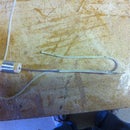Introduction: Construct Curves to Smoothly Connect Lines at Any Angle
One of the steps when building my son's Optimist dinghy (similar to this 'ible) was to attach "knees" in all corners. Here the task was to find/construct a curve which neatly "connects" side and front edges. Now what can be done to acomplish this:
- grab all round plates, pots, coffee and corned beef cans you can find and look if one of their diameters is roughly what you need
- construct a curve which exactly does what you want
I went for (2) by the following steps ...
Step 1: Mark Edges
First step is to mark the edges which should be connected by a curve.
In my case I chose to do this "in situ", but the method will be the same if you do this on a sheet of paper. What needs to be found are
- the angle at which two lines intersect
- start and endpoints of the connecting curve on these two lines
Working "in situ" has the advantage that the two lines can be found easily by holding a ruler against the edges and just extending the edge line. The curve enpoints were chosen to lie on the very edges of the plates.
Step 2: Divide
Next is to divide the lines between curve endpoints and intersection into equal pieces. My lines were measured to (roughly ;-) 100 and 130mm so I chose to divide them in 10 equal spaces of 10 and 13mm, respectively.
As you can see on the 2nd picture, the 10th divider of the vertical line isn't "exactly" meeting the intersection with the other edge line due to the fact that the measure was 103mm - a difference I chose to neglect - the error is small enough in practice.
Step 3: Draw Tangents
Last step is to draw the curve tangents in the following way
- You start with a tangent from 1st division mark after endpoint on 1st edge line to the first mark from intersection on the 2nd edge line
- You advance from mark to mark until you have connected last mark before intersection on 1st edge line to last mark before endpoint on 2nd edge line
E voila - you have just created a set of tangents along which you can cut / file / sand to obtain a nice curve connecting two edges at any desired angle.
Step 4: For the Curious - Background
For those of you who are curious: mathematically speaking this curve is not part of a circle but a parabolic curve.
Let's compare this parabolic line with a circle
case 1: edges are of equal length
- circle center can be found by intersecting perpendicular lines through the edge endpoints
- circle removes slightly less material
- circle radius equals edge length only for 90° angle
case 2: edges are of different length
- circle can be found by intersecting perpendicular lines at distances equal to the length of the shorter edge
- circle meets the shorter edge but not the longer edge
note: pictures in this section show
- black: parabola construction
- blue: construction of circle center
- red: best fitting circle
I'm not commenting on the aestethic aspect here ... personal point of view
I hope you like this idea as much as I liked to construct my "knees" according to this method and document it. Kind regards Mike













